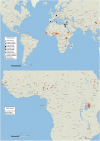Crop diversification and parasitic weed abundance: a global meta-analysis
- PMID: 36371505
- PMCID: PMC9653488
- DOI: 10.1038/s41598-022-24047-2
Crop diversification and parasitic weed abundance: a global meta-analysis
Abstract
Parasitic weeds cause huge annual losses to food production globally. A small number of species from the genera Cuscuta, Orobanche, Phelipanche and Striga have proliferated across many agroecological zones. Their control is compromised due to the lack of efficacy of conventional herbicides and their rapid adaptation to new resistant crop cultivars. A broad range of studies suggest consistent reductions in parasitic weed densities owing to increased spatial (intercropping) and temporal diversity (crop rotation). However, to date, no synthesis of this body of research has been published. Here we report the results of a meta-analysis using 1525 paired observations from 67 studies across 24 countries, comparing parasitic weed density and crop yields from monocrop and more diverse cropping systems. We found both spatial and temporal crop diversification had a significant effect on parasitic weed density reduction. Furthermore, our results show effects of spatial diversification are stronger in suppressing parasitic weeds than temporal effects. Furthermore, the analysis indicates intercrops which alter both microclimate and soil chemistry (e.g. Crotalaria, Stylosanthes, Berseem clover and Desmodium) are most effective in parasitic weed management. This analysis serves to underline the viability of crop diversification as a tool to enhance food security globally.
© 2022. The Author(s).
Conflict of interest statement
The authors declare no competing interests.
Figures





Similar articles
-
Companion cropping to manage parasitic plants.Annu Rev Phytopathol. 2010;48:161-77. doi: 10.1146/annurev-phyto-073009-114433. Annu Rev Phytopathol. 2010. PMID: 20429664 Review.
-
Crop Rotation and Intercropping Strategies for Weed Management.Ecol Appl. 1993 Feb;3(1):92-122. doi: 10.2307/1941795. Ecol Appl. 1993. PMID: 27759234
-
Suicidal germination for parasitic weed control.Pest Manag Sci. 2016 Nov;72(11):2016-2025. doi: 10.1002/ps.4222. Epub 2016 Feb 15. Pest Manag Sci. 2016. PMID: 26733056
-
Induction of Haustorium Development by Sphaeropsidones in Radicles of the Parasitic Weeds Striga and Orobanche. A Structure-Activity Relationship Study.J Agric Food Chem. 2016 Jun 29;64(25):5188-96. doi: 10.1021/acs.jafc.6b01910. Epub 2016 Jun 16. J Agric Food Chem. 2016. PMID: 27267731
-
Observations on the current status of Orobanche and Striga problems worldwide.Pest Manag Sci. 2009 May;65(5):453-9. doi: 10.1002/ps.1713. Pest Manag Sci. 2009. PMID: 19206075 Review.
Cited by
-
(±)-Catechins inhibit prehaustorium formation in the parasitic weed Phelipanche ramosa and reduce tomato infestation.Pest Manag Sci. 2025 Feb;81(2):720-726. doi: 10.1002/ps.8472. Epub 2024 Oct 5. Pest Manag Sci. 2025. PMID: 39367679 Free PMC article.
References
-
- Chauhan BS. Grand challenges in weed management. Front. Agron. 2020 doi: 10.3389/fagro.2019.00003. - DOI
-
- Oerke EC. Crop losses to pests. J. Agric. Sci. 2006;144:31–43.
-
- Samejima H, Sugimoto Y. Recent research progress in combatting root parasitic weeds. Biotechnol. Biotechnol. Equip. 2018;32(2):221–240.
-
- Aly R. Conventional and biotechnological approaches for control of parasitic weeds. In Vitro Cell. Dev. Biol. Plant. 2007;43(4):304–317.
Publication types
MeSH terms
LinkOut - more resources
Full Text Sources

